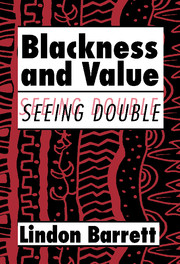Book contents
- Frontmatter
- Contents
- Acknowledgments
- Introduction: “In the Dark”
- Part One Violence and the Unsightly
- 1 Figures of Violence: Valuation, Authorization, Expenditures of the African American, and Other Ways of Telling
- 2 Figuring Others of Value: Singing Voices, Signing Voices, and African American Culture
- 3 (Further) Figures of Violence: The Street in the U. S. Landscape
- Part Two Reasonings and Reasonablenesses
- Part Three Phonic and Scopic Economies
- Notes
- Bibliography
- Index
1 - Figures of Violence: Valuation, Authorization, Expenditures of the African American, and Other Ways of Telling
Published online by Cambridge University Press: 18 December 2009
- Frontmatter
- Contents
- Acknowledgments
- Introduction: “In the Dark”
- Part One Violence and the Unsightly
- 1 Figures of Violence: Valuation, Authorization, Expenditures of the African American, and Other Ways of Telling
- 2 Figuring Others of Value: Singing Voices, Signing Voices, and African American Culture
- 3 (Further) Figures of Violence: The Street in the U. S. Landscape
- Part Two Reasonings and Reasonablenesses
- Part Three Phonic and Scopic Economies
- Notes
- Bibliography
- Index
Summary
Within the first few pages of her autobiography Lady Sings the Blues, Billie Holiday (with William Dufty) recounts an entrepreneurial enterprise she undertakes at the age of sixteen. The enterprise brings Holiday quickly to the point of a confrontation, one in which she learns to negotiate the complexities and ritual importance of boundaries and borders to her advantage. Sixteen-year-old Holiday, rather than scrub neighborhood steps for a nickel, buys her own supplies and demands an exorbitant fifteen cents for each set of steps she would scrub. Her demands are met with incredulity, but Holiday is fortified with the understanding that
[a]ll these bitches were lazy. I knew it and that's where I had them. They didn't care how filthy their damn houses were inside, as long as those white steps were clean. Sometimes I'd bring home as much as ninety cents a day. I even made as high as $2.10 – that's fourteen kitchen or bathroom floors and as many sets of steps. (10)
Holiday, big for her age, “with big breasts, big bones, a big fat healthy broad, that's all” (9), keenly understands and exploits the paramount significance given to markers setting off inside from outside, as well as her position in relation to such markers. Across the boundary – the set of steps – that she will scrub and maintain “white,” Holiday faces her adversarial benefactor and plays upon her own intuitive knowledge of both the significance attributed to the boundary and the relative positions she and her adversary occupy in relation to the boundary, one inside and one outside.
- Type
- Chapter
- Information
- Blackness and ValueSeeing Double, pp. 11 - 54Publisher: Cambridge University PressPrint publication year: 1998



